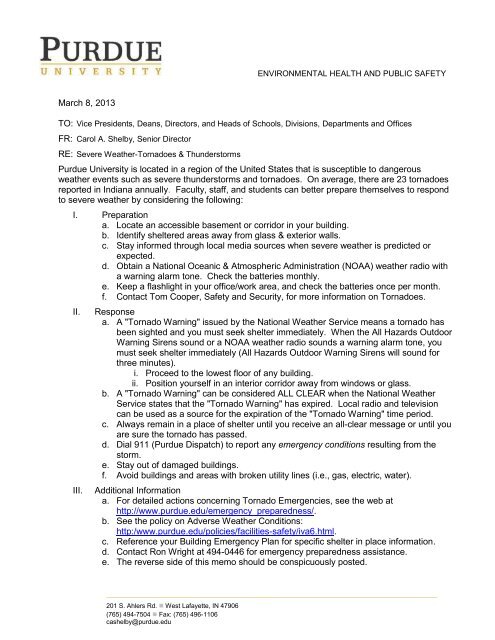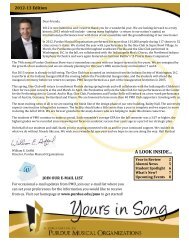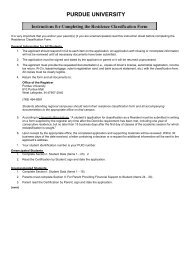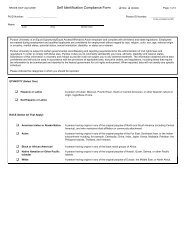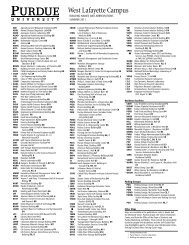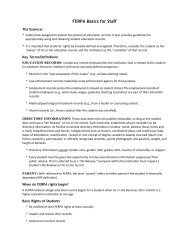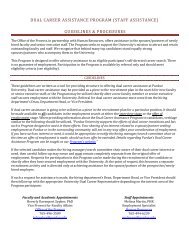Tornado Preparedness - Purdue University
Tornado Preparedness - Purdue University
Tornado Preparedness - Purdue University
You also want an ePaper? Increase the reach of your titles
YUMPU automatically turns print PDFs into web optimized ePapers that Google loves.
ENVIRONMENTAL HEALTH AND PUBLIC SAFETY<br />
March 8, 2013<br />
TO: Vice Presidents, Deans, Directors, and Heads of Schools, Divisions, Departments and Offices<br />
FR: Carol A. Shelby, Senior Director<br />
RE: Severe Weather-<strong>Tornado</strong>es & Thunderstorms<br />
<strong>Purdue</strong> <strong>University</strong> is located in a region of the United States that is susceptible to dangerous<br />
weather events such as severe thunderstorms and tornadoes. On average, there are 23 tornadoes<br />
reported in Indiana annually. Faculty, staff, and students can better prepare themselves to respond<br />
to severe weather by considering the following:<br />
I. Preparation<br />
a. Locate an accessible basement or corridor in your building.<br />
b. Identify sheltered areas away from glass & exterior walls.<br />
c. Stay informed through local media sources when severe weather is predicted or<br />
expected.<br />
d. Obtain a National Oceanic & Atmospheric Administration (NOAA) weather radio with<br />
a warning alarm tone. Check the batteries monthly.<br />
e. Keep a flashlight in your office/work area, and check the batteries once per month.<br />
f. Contact Tom Cooper, Safety and Security, for more information on <strong>Tornado</strong>es.<br />
II.<br />
III.<br />
Response<br />
a. A "<strong>Tornado</strong> Warning" issued by the National Weather Service means a tornado has<br />
been sighted and you must seek shelter immediately. When the All Hazards Outdoor<br />
Warning Sirens sound or a NOAA weather radio sounds a warning alarm tone, you<br />
must seek shelter immediately (All Hazards Outdoor Warning Sirens will sound for<br />
three minutes).<br />
i. Proceed to the lowest floor of any building.<br />
ii. Position yourself in an interior corridor away from windows or glass.<br />
b. A "<strong>Tornado</strong> Warning" can be considered ALL CLEAR when the National Weather<br />
Service states that the "<strong>Tornado</strong> Warning" has expired. Local radio and television<br />
can be used as a source for the expiration of the "<strong>Tornado</strong> Warning" time period.<br />
c. Always remain in a place of shelter until you receive an all-clear message or until you<br />
are sure the tornado has passed.<br />
d. Dial 911 (<strong>Purdue</strong> Dispatch) to report any emergency conditions resulting from the<br />
storm.<br />
e. Stay out of damaged buildings.<br />
f. Avoid buildings and areas with broken utility lines (i.e., gas, electric, water).<br />
Additional Information<br />
a. For detailed actions concerning <strong>Tornado</strong> Emergencies, see the web at<br />
http://www.purdue.edu/emergency_preparedness/.<br />
b. See the policy on Adverse Weather Conditions:<br />
http:/www.purdue.edu/policies/facilities-safety/iva6.html.<br />
c. Reference your Building Emergency Plan for specific shelter in place information.<br />
d. Contact Ron Wright at 494-0446 for emergency preparedness assistance.<br />
e. The reverse side of this memo should be conspicuously posted.<br />
__________________________________________________________________________________<br />
201 S. Ahlers Rd. • West Lafayette, IN 47906<br />
(765) 494-7504 • Fax: (765) 496-1106<br />
cashelby@purdue.edu
TORNADO WATCH<br />
TORNADO PROCEDURES<br />
<strong>Purdue</strong> <strong>University</strong><br />
West Lafayette Campus<br />
A “<strong>Tornado</strong> Watch” is issued when atmospheric conditions are favorable for the<br />
formation of tornadoes in a given area. Under these conditions, stay informed by<br />
listening to radio or television.<br />
A TORNADO WARNING<br />
A “<strong>Tornado</strong> Warning” indicates that a tornado has been sighted and poses a definite<br />
threat to a given area. Take cover as soon as possible.<br />
WARNING SIGNALS<br />
<br />
<br />
<br />
A NOAA weather alert radio will sound the appropriate alert as required by the<br />
National Weather Service.<br />
Outdoor sirens will sound for a period in excess of three minutes. When this occurs,<br />
seek shelter, tune into local radio and TV stations to determine the nature of the<br />
emergency.<br />
A voice message will be broadcast over WBAA, Boiler TV, and other local radio and<br />
television stations.<br />
The ALL CLEAR signal is announced by radio and television stations.<br />
WHEN TAKING SHELTER<br />
Proceed to the basement of any building that has a basement or subwalk. Position<br />
yourself in an interior corridor of the area away from glass. Be prepared to kneel facing<br />
a wall and cover your head.<br />
SEVERE THUNDERSTORMS<br />
The National Weather Service issues severe thunderstorm watches and warnings.<br />
Remember that tornadoes are spawned from severe thunderstorms, so monitor NOAA<br />
weather alerts.<br />
SIREN TESTING<br />
The exterior warning sirens are tested at 11:00 a.m. on the first Saturday of every<br />
month except during periods of adverse weather conditions.<br />
Prepared by Carol Shelby Environmental Health and Public Safety<br />
494-7504 2/15/13


